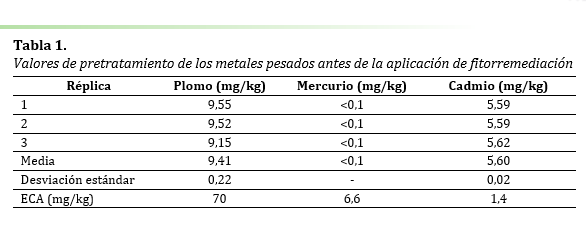Phytoremediation with Medicago sativa and Taraxacum officinale for the remediation of heavy metal-contaminated soil from a landfill site
DOI:
https://doi.org/10.51252/reacae.v3i1.649Keywords:
contamination, phytotechnology, toxicity, treatmentAbstract
Phytotechnology through phytoremediation has definite advantages such as efficiency and reduced cost of its application for the remediation of contaminated soils compared to conventional physicochemical techniques. In this study, the potential of Medicago sativa and Taraxacum officinale species to remediate soils contaminated with heavy metals (lead, mercury and cadmium) at the Yacucatina solid waste dump was evaluated. Although the initial concentration of lead in the soil (9.41 mg/kg) was below the ECA of 70 mg/kg, cadmium (5.60 mg/kg) exceeded the permitted limit of 1.4 mg/kg. After applying phytoremediation with Medicago sativa, the average concentration of lead decreased to 8.50 mg/kg and cadmium to 1.13 mg/kg, while with Taraxacum officinale the final values were 7.39 mg/kg for lead and 1.36 mg/kg for cadmium, complying with environmental standards. In terms of removal efficiency, Medicago sativa showed an efficiency of 9.68 % for lead and 79.82 % for cadmium, while Taraxacum officinale showed an efficiency of 21.57 % for lead and 75.71 % for cadmium; concluding that both species showed promise for the decontamination of soils affected by heavy metals.
Downloads
References
Alves, A. R. A., Yin, Q., Oliveira, R. S., Silva, E. F., & Novo, L. A. B. (2022). Plant growth-promoting bacteria in phytoremediation of metal-polluted soils: Current knowledge and future directions. Science of The Total Environment, 838, 156435. https://doi.org/10.1016/j.scitotenv.2022.156435
Bhat, S. A., Bashir, O., Ul Haq, S. A., Amin, T., Rafiq, A., Ali, M., Américo-Pinheiro, J. H. P., & Sher, F. (2022). Phytoremediation of heavy metals in soil and water: An eco-friendly, sustainable and multidisciplinary approach. Chemosphere, 303, 134788. https://doi.org/10.1016/j.chemosphere.2022.134788
Irfan, M., Mudassir, M., Khan, M. J., Dawar, K. M., Muhammad, D., Mian, I. A., Ali, W., Fahad, S., Saud, S., Hayat, Z., Nawaz, T., Khan, S. A., Alam, S., Ali, B., Banout, J., Ahmed, S., Mubeen, S., Danish, S., Datta, R., … Dewil, R. (2021). Heavy metals immobilization and improvement in maize (Zea mays L.) growth amended with biochar and compost. Scientific Reports, 11(1), 18416. https://doi.org/10.1038/s41598-021-97525-8
Liu, Z., Chen, B., Wang, L., Urbanovich, O., Nagorskaya, L., Li, X., & Tang, L. (2020). A review on phytoremediation of mercury contaminated soils. Journal of Hazardous Materials, 400, 123138. https://doi.org/10.1016/j.jhazmat.2020.123138
Munive, R., Gamarra, G., Munive, Y., Puertas, F., Valdiviezo, L., & Cabello, R. (2020). Lead and cadmium uptake by sunflower from contaminated soil and remediated with organic amendments in the form of compost and vermicompost. Scientia Agropecuaria, 11(2), 177–186. https://doi.org/10.17268/sci.agropecu.2020.02.04
Patra, D. K., Acharya, S., Pradhan, C., & Patra, H. K. (2021). Poaceae plants as potential phytoremediators of heavy metals and eco-restoration in contaminated mining sites. Environmental Technology & Innovation, 21, 101293. https://doi.org/10.1016/j.eti.2020.101293
Raza, A., Habib, M., Kakavand, S. N., Zahid, Z., Zahra, N., Sharif, R., & Hasanuzzaman, M. (2020). Phytoremediation of Cadmium: Physiological, Biochemical, and Molecular Mechanisms. Biology, 9(7), 177. https://doi.org/10.3390/biology9070177
Torres-Gonzales, Y., Rojas-Carrizales, A. G., Salas-Contreras, W. H., & Hinojosa-Benavides, R. A. (2021). Fitorremediación de Suelos Contaminados por Metales Pesados. Scientific Research Journal CIDI, 1(1), 25–36. https://doi.org/10.53942/srjcidi.v1i1.43
Yan, A., Wang, Y., Tan, S. N., Mohd Yusof, M. L., Ghosh, S., & Chen, Z. (2020). Phytoremediation: A Promising Approach for Revegetation of Heavy Metal-Polluted Land. Frontiers in Plant Science, 11. https://doi.org/10.3389/fpls.2020.00359

Downloads
Published
How to Cite
Issue
Section
License
Copyright (c) 2024 Karina Silva-Mori, Wildoro Ramírez Ramírez, Delmester Chuquimbalqui-Marina, Yrwin Daniel Azabache-Aliaga

This work is licensed under a Creative Commons Attribution 4.0 International License.
The authors retain their rights:
a. The authors retain their trademark and patent rights, as well as any process or procedure described in the article.
b. The authors retain the right to share, copy, distribute, execute and publicly communicate the article published in the Revista Amazónica de Ciencias Ambientales y Ecológicas (REACAE) (for example, place it in an institutional repository or publish it in a book), with an acknowledgment of its initial publication in the REACAE.
c. Authors retain the right to make a subsequent publication of their work, to use the article or any part of it (for example: a compilation of their works, notes for conferences, thesis, or for a book), provided that they indicate the source of publication (authors of the work, journal, volume, number and date).



